Changes in Fatty Acid Dietary Profile Affect the Brain–Gut Axis Functions of Healthy Young Adult Rats in a Sex-Dependent Manner
Abstract
:1. Introduction
2. Materials and Methods
2.1. Ethics Statement
2.2. Animals
2.3. Diets
2.4. Experimental Protocol
2.5. General Health Parameters
2.5.1. Body Weight, Food, and Water Intake
2.5.2. Plasma Levels of Glucose, Cholesterol, and Triglycerides
2.6. Brain Functions
2.6.1. Splash Test
2.6.2. Hole-Board Test
2.6.3. Somatic Sensitivity
Von Frey Test
Plantar Test
Pressure Administration Device Test
2.6.4. Locomotor Activity Analysis
2.7. Gastrointestinal Functions
2.7.1. Gastrointestinal Motility Analysis
2.7.2. Colonic Bead Expulsion Test
2.7.3. Colonic Sensitivity Analysis
2.8. Macroscopic Analysis
2.9. Histological Analysis
2.10. Statistical Analysis
3. Results
3.1. General Health Parameters
3.2. Brain Functions
3.3. Gastrointestinal Functions
3.3.1. Radiographic Analysis of Gastrointestinal Motor Function
Semiquantitative Score of Gastrointestinal Motility
Morphometric and Densitometric Analysis of Stomach and Cecum
Number, Size, and Density of Fecal Pellets
3.3.2. Colonic Propulsion
3.3.3. Colonic Sensitivity
3.4. Macroscopic Features of the Gastrointestinal Organs
3.5. Microscopic Features of Gut Wall
4. Discussion
4.1. Gastrointestinal Tract Motor Function Evaluation
4.2. Behavioral Tests
4.2.1. Emotional Alterations
4.2.2. Somatic and Visceral Nociception
4.3. Limitations
5. Conclusions
Supplementary Materials
Author Contributions
Funding
Institutional Review Board Statement
Informed Consent Statement
Data Availability Statement
Acknowledgments
Conflicts of Interest
Appendix A
| Male | Female | |||||
|---|---|---|---|---|---|---|
| SOY | COCO | EP | SOY | COCO | EP | |
| Number of animals per group (n) | 14 | 14 | 16 | 12 | 12 | 12 |
| Initial range | 281–295 | 275–305 | 299–305 | 187–242 | 166–231 | 189–234 |
| Initial weight (g) | 287.5 ± 5.5 | 287.3 ± 10.76 | 302.5 ± 2.59 ** | 212.6 ± 20.95 | 213.0 ± 17.38 | 205.9 ± 12.32 |
| Points | Proportion of the Organ Labelled | Intensity of Labelling | Profile of the Organ † | Homogeneity of Labelling in the Organ † |
|---|---|---|---|---|
| 0 | No labeling | |||
| 0–1 | <25% | Faint | Not well-defined | Heterogeneous |
| 2 | 25–50% | Light | Well-defined | Homogeneous |
| 3 | 50–75% | Moderate | ||
| 4 | 75–100% | Strong |
References
- Wali, J.A.; Jarzebska, N.; Raubenheimer, D.; Simpson, S.J.; Rodionov, R.N.; O’Sullivan, J.F. Cardio-Metabolic Effects of High-Fat Diets and Their Underlying Mechanisms—A Narrative Review. Nutrients 2020, 12, 1505. [Google Scholar] [CrossRef] [PubMed]
- Chakraborty, T.R.; Donthireddy, L.; Adhikary, D.; Chakraborty, S. Long-Term High Fat Diet Has a Profound Effect on Body Weight, Hormone Levels, and Estrous Cycle in Mice. Med. Sci. Monit. 2016, 22, 1601–1608. [Google Scholar] [CrossRef] [PubMed] [Green Version]
- Bos, D.J.; Van Montfort, S.J.; Oranje, B.; Durston, S.; Smeets, P.A. Effects of omega-3 polyunsaturated fatty acids on human brain morphology and function: What is the evidence? Eur. Neuropsychopharmacol. 2016, 26, 546–561. [Google Scholar] [CrossRef] [PubMed]
- Olliver, M.; Veysey, M.; Lucock, M.; Niblett, S.; King, K.; MacDonald-Wicks, L.; Garg, M.L. Erythrocyte omega-3 polyunsaturated fatty acid levels are associated with biomarkers of inflammation in older Australians. J. Nutr. Intermed. Metab. 2016, 5, 61–69. [Google Scholar] [CrossRef] [Green Version]
- Endo, J.; Arita, M. Cardioprotective mechanism of omega-3 polyunsaturated fatty acids. J. Cardiol. 2016, 67, 22–27. [Google Scholar] [CrossRef] [PubMed] [Green Version]
- Titz, B.; Luettich, K.; Leroy, P.; Boue, S.; Vuillaume, G.; Vihervaara, T.; Ekroos, K.; Martin, F.; Peitsch, M.C.; Hoeng, J. Alterations in Serum Polyunsaturated Fatty Acids and Eicosanoids in Patients with Mild to Moderate Chronic Obstructive Pulmonary Disease (COPD). Int. J. Mol. Sci. 2016, 17, 1583. [Google Scholar] [CrossRef] [PubMed] [Green Version]
- Brouwers, H.; Von Hegedus, J.; Toes, R.; Kloppenburg, M.; Ioan-Facsinay, A. Lipid mediators of inflammation in rheumatoid arthritis and osteoarthritis. Best Pract. Res. Clin. Rheumatol. 2015, 29, 741–755. [Google Scholar] [CrossRef] [PubMed]
- Lorente-Cebrián, S.; Costa, A.G.V.; Navas-Carretero, S.; Zabala, M.; Laiglesia, L.M.; Martínez, J.A.; Moreno-Aliaga, M.J. An update on the role of omega-3 fatty acids on inflammatory and degenerative diseases. J. Physiol. Biochem. 2015, 71, 341–349. [Google Scholar] [CrossRef] [PubMed]
- Brasky, T.M.; Darke, A.K.; Song, X.; Tangen, C.M.; Goodman, P.J.; Thompson, I.M.; Meyskens, F.L., Jr.; Goodman, G.E.; Minasian, L.M.; Parnes, H.L.; et al. Plasma phospholipid fatty acids and prostate cancer risk in the SELECT trial. J. Natl. Cancer Inst. 2013, 105, 1132–1141. [Google Scholar] [CrossRef] [Green Version]
- Labanski, A.; Langhorst, J.; Engler, H.; Elsenbruch, S. Stress and the brain-gut axis in functional and chronic-inflammatory gastrointestinal diseases: A transdisciplinary challenge. Psychoneuroendocrinology 2020, 111, 104501. [Google Scholar] [CrossRef]
- Enck, P.; Aziz, Q.; Barbara, G.; Farmer, A.D.; Fukudo, S.; Mayer, E.A.; Niesler, B.; Quigley, E.M.; Rajilić-Stojanović, M.; Schemann, M.; et al. Irritable bowel syndrome. Nat. Rev. Dis. Prim. 2016, 2, 16014. [Google Scholar] [CrossRef] [Green Version]
- Ross, B.M.; Seguin, J.; Sieswerda, L.E. Omega-3 fatty acids as treatments for mental illness: Which disorder and which fatty acid? Lipids Health Dis. 2007, 6, 21. [Google Scholar] [CrossRef] [Green Version]
- Fedorova, I.; Salem, N., Jr. Omega-3 fatty acids and rodent behavior. Prostagland. Leukot. Essent. Fat. Acids 2006, 75, 271–289. [Google Scholar] [CrossRef]
- Bhatia, H.S.; Agrawal, R.; Sharma, S.; Huo, Y.-X.; Ying, Z.; Gomez-Pinilla, F. Omega-3 Fatty Acid Deficiency during Brain Maturation Reduces Neuronal and Behavioral Plasticity in Adulthood. PLoS ONE 2011, 6, e28451. [Google Scholar] [CrossRef] [Green Version]
- Gancheva, S.; Galunska, B.; Zhelyazkova-Savova, M. Diets rich in saturated fat and fructose induce anxiety and depression-like behaviours in the rat: Is there a role for lipid peroxidation? Int. J. Exp. Pathol. 2017, 98, 296–306. [Google Scholar] [CrossRef]
- Arranz, L.-I.; Rafecas, M.; Alegre, C. Effects of Obesity on Function and Quality of Life in Chronic Pain Conditions. Curr. Rheumatol. Rep. 2014, 16, 130. [Google Scholar] [CrossRef]
- Paulis, W.D.; Silva, S.; Koes, B.W.; Van Middelkoop, M. Overweight and obesity are associated with musculoskeletal complaints as early as childhood: A systematic review. Obes. Rev. 2014, 15, 52–67. [Google Scholar] [CrossRef]
- Song, Z.; Xie, W.; Chen, S.; Strong, J.A.; Print, M.S.; Wang, J.I.; Shareef, A.F.; Ulrich-Lai, Y.M.; Zhang, J.-M. High-fat diet increases pain behaviors in rats with or without obesity. Sci. Rep. 2017, 7, 10350. [Google Scholar] [CrossRef]
- Warschburger, P.; Hänig, M.J.; Friedt, M.; Posovszky, C.; Schier, M.; Calvano, M.C. Health-Related Quality of Life in Children With Abdominal Pain Due to Functional or Organic Gastrointestinal Disorders. J. Pediatr. Psychol. 2014, 39, 45–54. [Google Scholar] [CrossRef] [Green Version]
- Hart, A.R.; Luben, R.; Olsen, A.; Tjonneland, A.; Linseisen, J.; Nagel, G.; Berglund, G.; Lindgren, S.; Grip, O.; Key, T.; et al. Diet in the Aetiology of Ulcerative Colitis: A European Prospective Cohort Study. Digestion 2008, 77, 57–64. [Google Scholar] [CrossRef]
- Uranga, J.A.; López-Miranda, V.; Lombó, F.; Abalo, R. Food, nutrients and nutraceuticals affecting the course of inflammatory bowel disease. Pharmacol. Rep. 2016, 68, 816–826. [Google Scholar] [CrossRef] [PubMed]
- Lam, Y.Y.; Ha, C.W.Y.; Campbell, C.R.; Mitchell, A.J.; Dinudom, A.; Oscarsson, J.; Cook, D.I.; Hunt, N.H.; Caterson, I.D.; Holmes, A.J.; et al. Increased Gut Permeability and Microbiota Change Associate with Mesenteric Fat Inflammation and Metabolic Dysfunction in Diet-Induced Obese Mice. PLoS ONE 2012, 7, e34233. [Google Scholar] [CrossRef] [Green Version]
- Lam, Y.Y.; Ha, C.W.; Hoffmann, J.M.; Oscarsson, J.; Dinudom, A.; Mather, T.J.; Cook, D.I.; Hunt, N.H.; Caterson, I.D.; Holmes, A.J.; et al. Effects of dietary fat profile on gut permeability and microbiota and their relationships with metabolic changes in mice. Obesity 2015, 23, 1429–1439. [Google Scholar] [CrossRef] [PubMed]
- Ghosh, S.; DeCoffe, D.; Brown, K.; Rajendiran, E.; Estaki, M.; Dai, C.; Yip, A.; Gibson, D.L. Fish Oil Attenuates Omega-6 Polyunsaturated Fatty Acid-Induced Dysbiosis and Infectious Colitis but Impairs LPS Dephosphorylation Activity Causing Sepsis. PLoS ONE 2013, 8, e55468. [Google Scholar] [CrossRef]
- Deol, P.; Evans, J.R.; Dhahbi, J.M.; Chellappa, K.; Han, D.S.; Spindler, S.R.; Sladek, F.M. Soybean Oil Is More Obesogenic and Diabetogenic than Coconut Oil and Fructose in Mouse: Potential Role for the Liver. PLoS ONE 2015, 10, e0132672. [Google Scholar] [CrossRef] [Green Version]
- Matsumoto, Y.; Ishimi, Y.; Suzuki, T.; Kobayashi, K.-I.; Inoue, J.; Yamamoto, Y. Activation of peroxisome proliferator-activated receptor gamma/small heterodimer partner pathway prevents high fat diet-induced obesity and hepatic steatosis in Sprague–Dawley rats fed soybean meal. J. Nutr. Biochem. 2020, 75, 108250. [Google Scholar] [CrossRef]
- Lim, T.; Ryu, J.; Lee, K.; Park, S.Y.; Hwang, K.T. Protective Effects of Black Raspberry (Rubus occidentalis) Extract against Hypercholesterolemia and Hepatic Inflammation in Rats Fed High-Fat and High-Choline Diets. Nutrients 2020, 12, 2448. [Google Scholar] [CrossRef]
- Reeves, P.G. Components of the AIN-93 Diets as Improvements in the AIN-76A Diet. J. Nutr. 1997, 127, 838S–841S. [Google Scholar] [CrossRef]
- Lien, E.; Boyle, F.; Wrenn, J.; Perry, R.; Thompson, C.; Borzelleca, J. Comparison of AIN-76A and AIN-93G diets: A 13-week study in rats. Food Chem. Toxicol. 2001, 39, 385–392. [Google Scholar] [CrossRef]
- Mosińska, P.; Martín-Ruiz, M.; González, A.; López-Miranda, V.; Herradón, E.; Uranga, J.A.; Vera, G.; Sánchez-Yáñez, A.; Martín-Fontelles, M.I.; Fichna, J.; et al. Changes in the diet composition of fatty acids and fiber affect the lower gastrointestinal motility but have no impact on cardiovascular parameters: In vivo and in vitro studies. Neurogastroenterol. Motil. 2019, 31, e13651. [Google Scholar] [CrossRef]
- Mosińska, P.; Szczepaniak, A.; Wojciechowicz, T.; Skrzypski, M.; Nowak, K.; Fichna, J. Chain length of dietary fatty acids determines gastrointestinal motility and visceromotor function in mice in a fatty acid binding protein 4-dependent manner. Eur. J. Nutr. 2020, 59, 2481–2496. [Google Scholar] [CrossRef] [Green Version]
- Csongová, M.; Renczés, E.; Šarayová, V.; Mihalovičová, L.; Janko, J.; Gurecká, R.; Troise, A.D.; Vitaglione, P.; Šebeková, K. Maternal Consumption of a Diet Rich in Maillard Reaction Products Accelerates Neurodevelopment in F1 and Sex-Dependently Affects Behavioral Phenotype in F2 Rat Offspring. Foods 2019, 8, 168. [Google Scholar] [CrossRef] [Green Version]
- Díaz-Gerevini, G.T.; Daín, A.; Pasqualini, M.E.; López, C.B.; Eynard, A.R.; Repossi, G. Diabetic encephalopathy: Beneficial effects of supplementation with fatty acids ω3 and nordihydroguaiaretic acid in a spontaneous diabetes rat model. Lipids Health Dis. 2019, 18, 43. [Google Scholar] [CrossRef] [Green Version]
- López-Gómez, L.; Díaz-Ruano, S.; Girón, R.; López-Pérez, A.E.; Vera, G.; Herradón Pliego, E.; López-Miranda, V.; Nurgali, K.; Martín-Fontelles, M.I.; Uranga, J.A.; et al. Preclinical evaluation of the effects on the gastrointestinal tract of the antineoplastic drug vincristine repeatedly administered to rats. Neurogastroenterol. Motil. 2018, 30, e13399. [Google Scholar] [CrossRef]
- Bennett, G.J.; Hargreaves, K.M. A model of peripheral mononeuropathy in the rat. Pain 1990, 42, 255. [Google Scholar] [CrossRef]
- Bagüés, A.; Martín-Fontelles, M.I.; Esteban-Hernández, J.; Sánchez-Robles, E.M. Characterization of the nociceptive effect of carrageenan: Masseter versus gastrocnemius. Muscle Nerve 2017, 56, 804–813. [Google Scholar] [CrossRef]
- Abalo, R.; Cabezos, P.A.; Vera, G.; López-Pérez, A.E.; Martín, M.I. Cannabinoids may worsen gastric dysmotility induced by chronic cisplatin in the rat. Neurogastroenterol. Motil. 2013, 25, 373–382.e292. [Google Scholar] [CrossRef]
- Cabezos, P.A.; Vera, G.; Castillo, M.; Fernández-Pujol, R.; Martín, M.I.; Abalo, R. Radiological study of gastrointestinal motor activity after acute cisplatin in the rat. Temporal relationship with pica. Auton. Neurosci. 2008, 141, 54–65. [Google Scholar] [CrossRef]
- Vera, G.; Girón, R.; Martín-Fontelles, M.I.; Abalo, R. Radiographic dose-dependency study of loperamide effects on gastrointestinal motor function in the rat. Temporal relationship with nausea-like behavior. Neurogastroenterol. Motil. 2019, 31, e13621. [Google Scholar] [CrossRef]
- Mosińska, P.; Jacenik, D.; Sałaga, M.; Wasilewski, A.; Cygankiewicz, A.; Sibaev, A.; Mokrowiecka, A.; Małecka-Panas, E.; Pintelon, I.; Storr, M.; et al. FABP4 blocker attenuates colonic hypomotility and modulates white adipose tissue-derived hormone levels in mouse models mimicking constipation-predominant IBS. Neurogastroenterol. Motil. 2017, 30, e13272. [Google Scholar] [CrossRef]
- Fichna, J.; Schicho, R.; Andrews, C.N.; Bashashati, M.; Klompus, M.; McKay, D.M.; Sharkey, K.A.; Zjawiony, J.K.; Janecka, A.; Storr, M.A. Salvinorin A inhibits colonic transit and neurogenic ion transport in mice by activating kappa-opioid and cannabinoid receptors. Neurogastroenterol. Motil. 2009, 21, 1326-e128. [Google Scholar] [CrossRef] [PubMed]
- De La Cruz, S.T.; Iriondo-DeHond, A.; Herrera, T.; Lopez-Tofiño, Y.; Galvez-Robleño, C.; Prodanov, M.; Velazquez-Escobar, F.; Abalo, R.; Del Castillo, M.D. An Assessment of the Bioactivity of Coffee Silverskin Melanoidins. Foods 2019, 8, 68. [Google Scholar] [CrossRef] [PubMed] [Green Version]
- Martín-Ruíz, M.; Uranga, J.A.; Mosinska, P.; Fichna, J.; Nurgali, K.; Martín-Fontelles, M.I.; Abalo, R. Alterations of colonic sensitivity and gastric dysmotility after acute cisplatin and granisetron. Neurogastroenterol. Motil. 2019, 31, e13499. [Google Scholar] [CrossRef] [PubMed]
- López-Gómez, L.; López-Tofiño, Y.; Abalo, R. Dependency on sex and stimulus quality of nociceptive behavior in a conscious visceral pain rat model. Neurosci. Lett. 2021, 746, 135667. [Google Scholar] [CrossRef]
- Robert, A.; Nezamis, J.; Lancaster, C.; Hanchar, A.; Klepper, M. Enteropooling assay: A test for diarrhea produced by prostaglandins. Prostaglandins 1976, 11, 809–828. [Google Scholar] [CrossRef]
- Galarraga, M.; Campion, J.; Muñoz-Barrutia, A.; Boqué, N.; Moreno, H.; Martínez, J.A.; Milagro, F.; Ortiz-De-Solórzano, C. Adiposoft: Automated software for the analysis of white adipose tissue cellularity in histological sections. J. Lipid Res. 2012, 53, 2791–2796. [Google Scholar] [CrossRef] [Green Version]
- Galeazzi, F.; Blennerhassett, P.A.; Qiu, B.; O’Byrne, P.M.; Collins, S.M. Cigarette smoke aggravates experimental colitis in rats. Gastroenterology 1999, 117, 877–883. [Google Scholar] [CrossRef]
- Saccani, F.; Anselmi, L.; Jaramillo, I.; Bertoni, S.; Barocelli, E.; Sternini, C.; Francesca, S.; Laura, A.; Simona, B.; Elisabetta, B. Protective role of μ opioid receptor activation in intestinal inflammation induced by mesenteric ischemia/reperfusion in mice. J. Neurosci. Res. 2012, 90, 2146–2153. [Google Scholar] [CrossRef] [Green Version]
- Uranga, J.A.; Martínez, J.M.G.; García-Jiménez, C.; Vera, G.; Martín-Fontelles, M.I.; Abalo, R. Alterations in the small intestinal wall and motor function after repeated cisplatin in rat. Neurogastroenterol. Motil. 2017, 29, e13047. [Google Scholar] [CrossRef]
- Brower, M.; Grace, M.; Kotz, C.M.; Koya, V. Comparative analysis of growth characteristics of Sprague Dawley rats obtained from different sources. Lab. Anim. Res. 2015, 31, 166–173. [Google Scholar] [CrossRef] [Green Version]
- Giknis, M.L.A.; Clifford, C.B. Clinical Laboratory Parameters for Ctrl: Wi(han) Rats. Charles River Laboratories International. 2008, pp. 1–17. Available online: http://www.criver.com/files/pdfs/rms/wistarhan/rm_rm_r_wistar_han_clin_lab_parameters_08.aspx (accessed on 27 May 2021).
- Boehm, O.; Zur, B.; Koch, A.; Tran, N.; Freyenhagen, R.; Hartmann, M.; Zacharowski, K. Clinical chemistry reference database for Wistar rats and C57/BL6 mice. Biol. Chem. 2007, 388, 547–554. [Google Scholar] [CrossRef]
- Clouard, C.; Gerrits, W.J.; Van Kerkhof, I.; Smink, W.; Bolhuis, J.E. Dietary Linoleic and α-Linolenic Acids Affect Anxiety-Related Responses and Exploratory Activity in Growing Pigs. J. Nutr. 2014, 145, 358–364. [Google Scholar] [CrossRef] [Green Version]
- Sakayori, N.; Tokuda, H.; Yoshizaki, K.; Kawashima, H.; Innis, S.M.; Shibata, H.; Osumi, N. Maternal Nutritional Imbalance between Linoleic Acid and Alpha-Linolenic Acid Increases Offspring’s Anxious Behavior with a Sex-Dependent Manner in Mice. Tohoku J. Exp. Med. 2016, 240, 31–37. [Google Scholar] [CrossRef] [Green Version]
- Rodriguez-Navas, C.; Morselli, E.; Clegg, D.J. Sexually dimorphic brain fatty acid composition in low and high fat diet-fed mice. Mol. Metab. 2016, 5, 680–689. [Google Scholar] [CrossRef]
- Riedl, A.; Schmidtmann, M.; Stengel, A.; Goebel, M.; Wisser, A.-S.; Klapp, B.F.; Mönnikes, H. Somatic comorbidities of irritable bowel syndrome: A systematic analysis. J. Psychosom. Res. 2008, 64, 573–582. [Google Scholar] [CrossRef]
- Song, Z.; Xie, W.; Strong, J.A.; Berta, T.; Ulrich-Lai, Y.M.; Guo, Q.; Zhang, J.-M. High-fat diet exacerbates postoperative pain and inflammation in a sex-dependent manner. Pain 2018, 159, 1731–1741. [Google Scholar] [CrossRef]
- Sekar, S.; Panchal, S.K.; Ghattamaneni, N.K.; Brown, L.; Crawford, R.; Xiao, Y.; Prasadam, I. Dietary Saturated Fatty Acids Modulate Pain Behaviour in Trauma-Induced Osteoarthritis in Rats. Nutrients 2020, 12, 509. [Google Scholar] [CrossRef] [Green Version]
- Kelley, A.E. Locomotor Activity and Exploration in Techniques in the Behavioral and Neural Sciences; Van Haaren, F., Ed.; Elseviers Science: Amsterdam, The Netherlands, 1993; pp. 499–518. [Google Scholar]
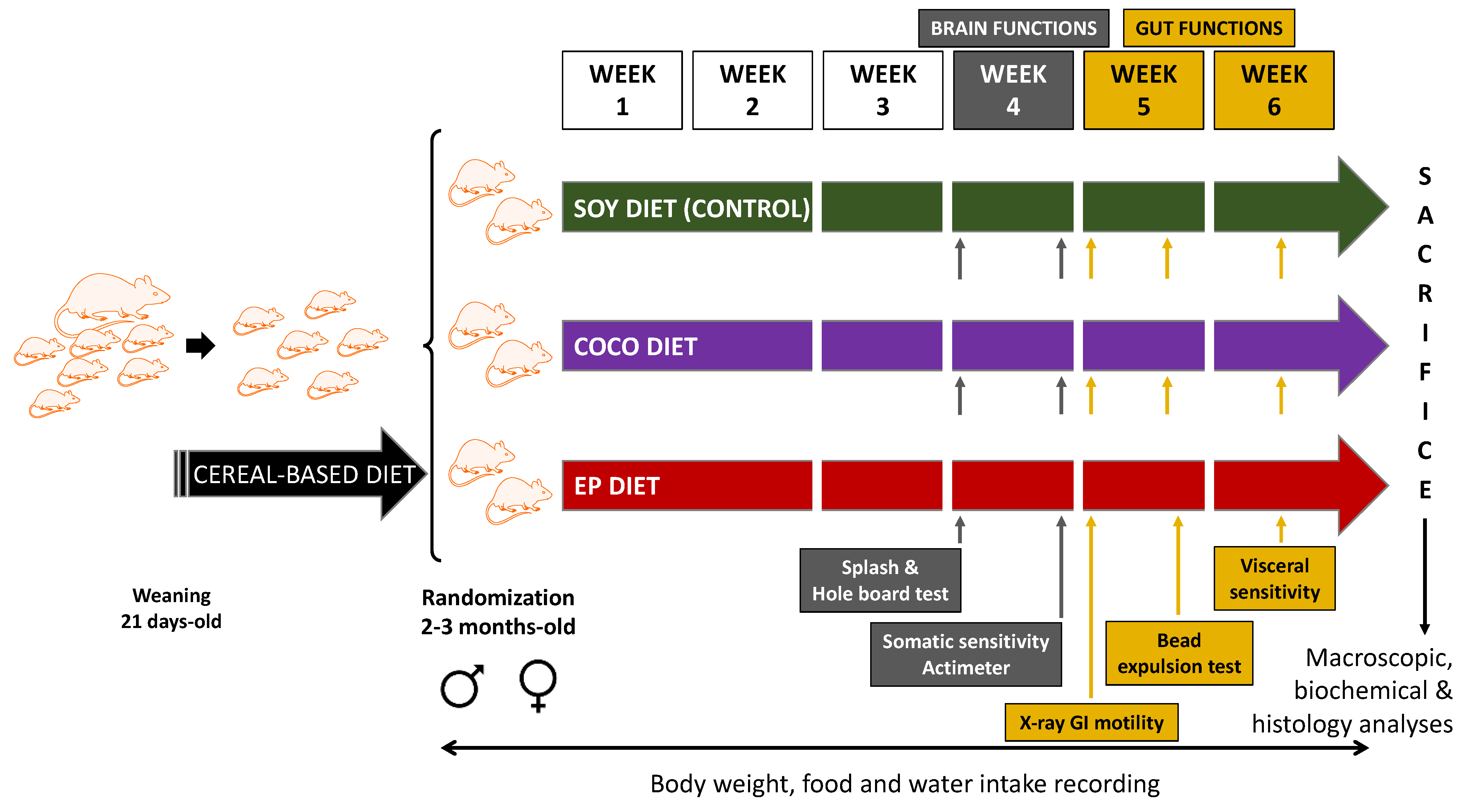
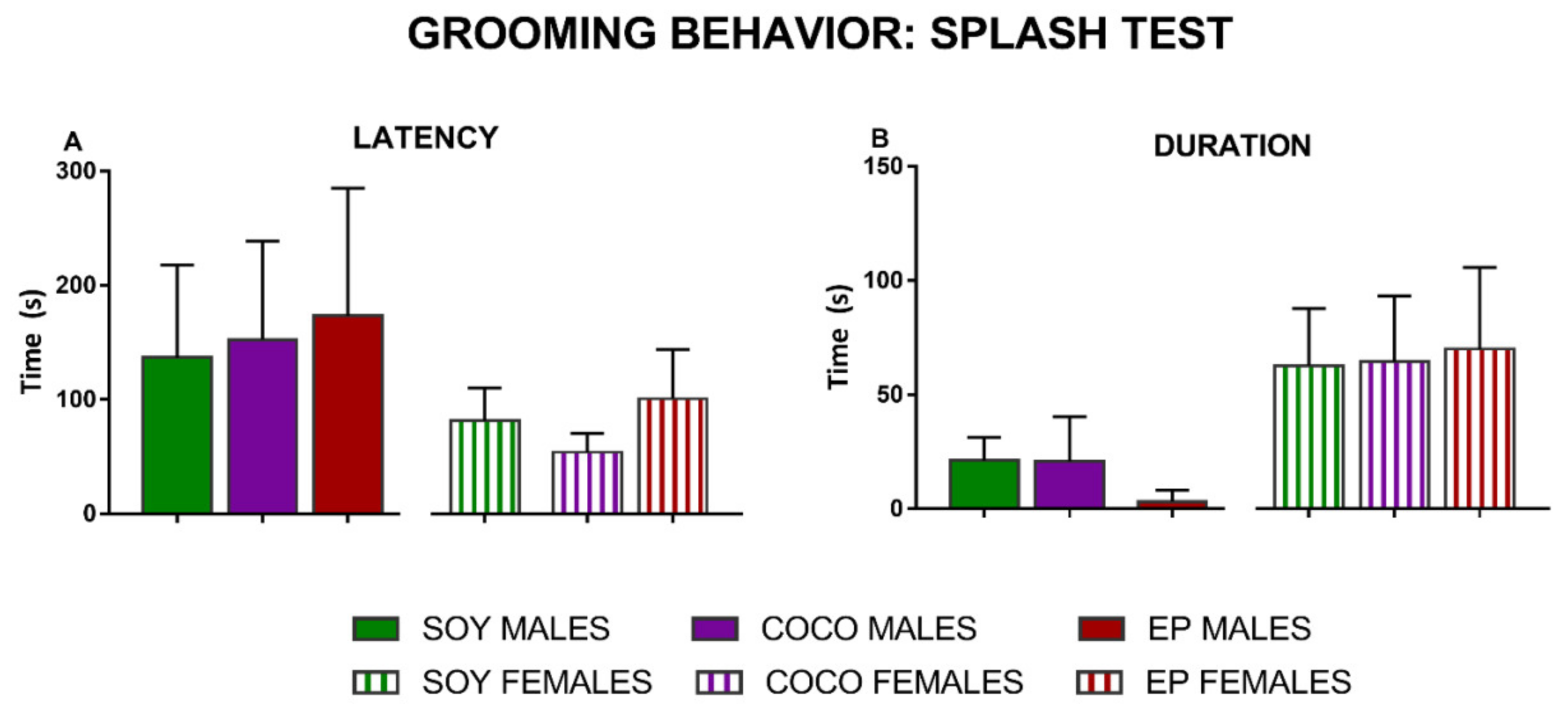
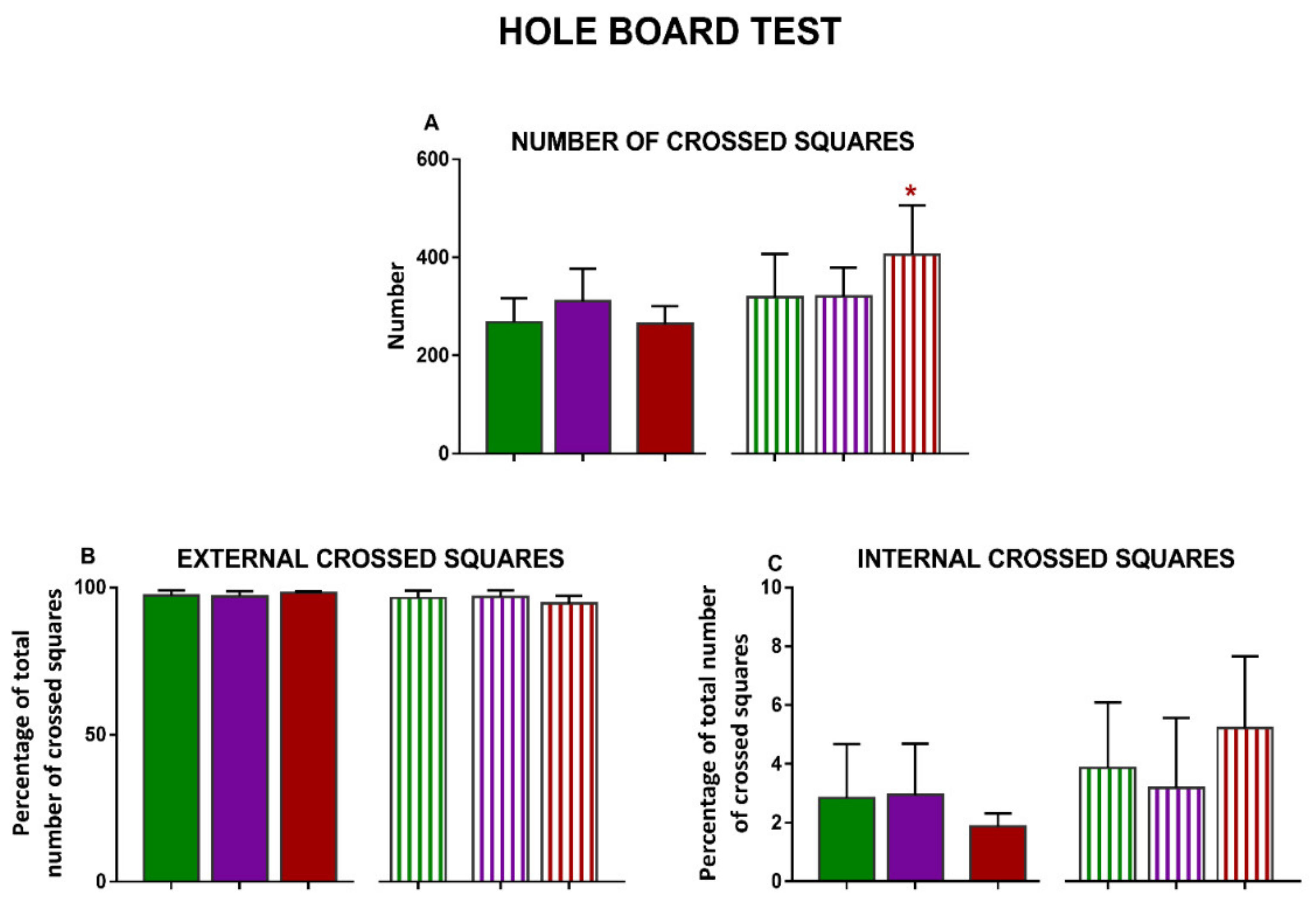

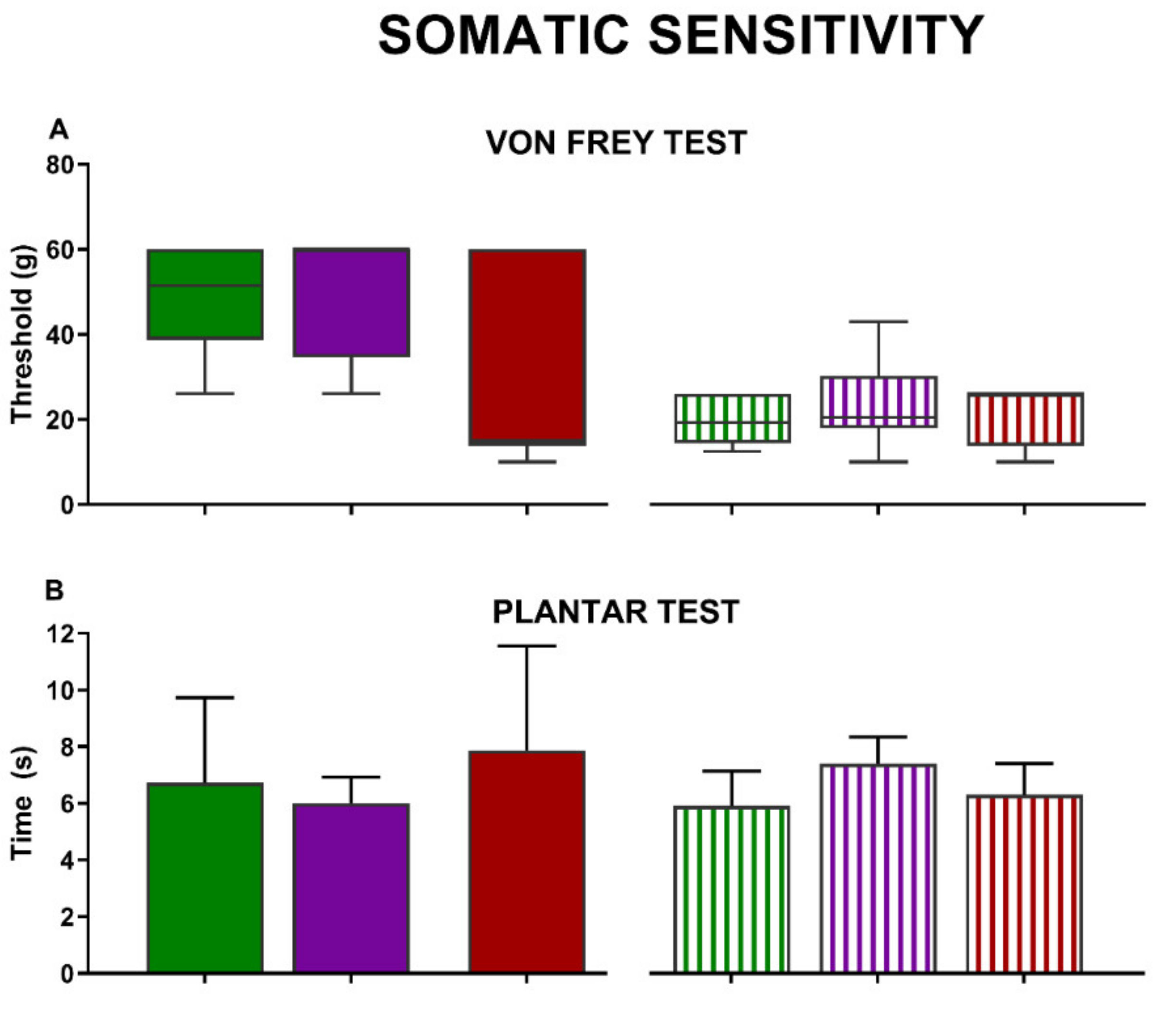

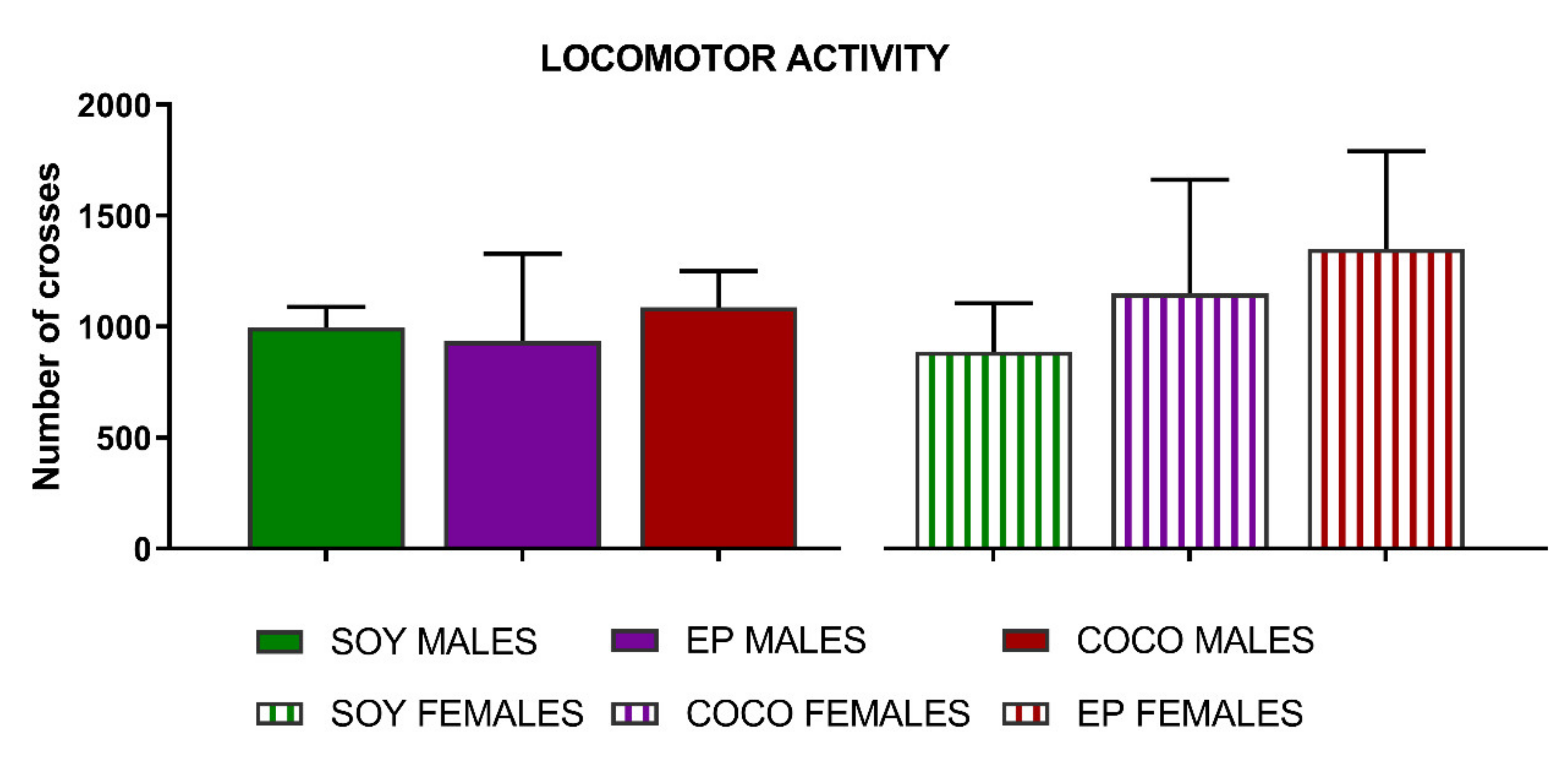




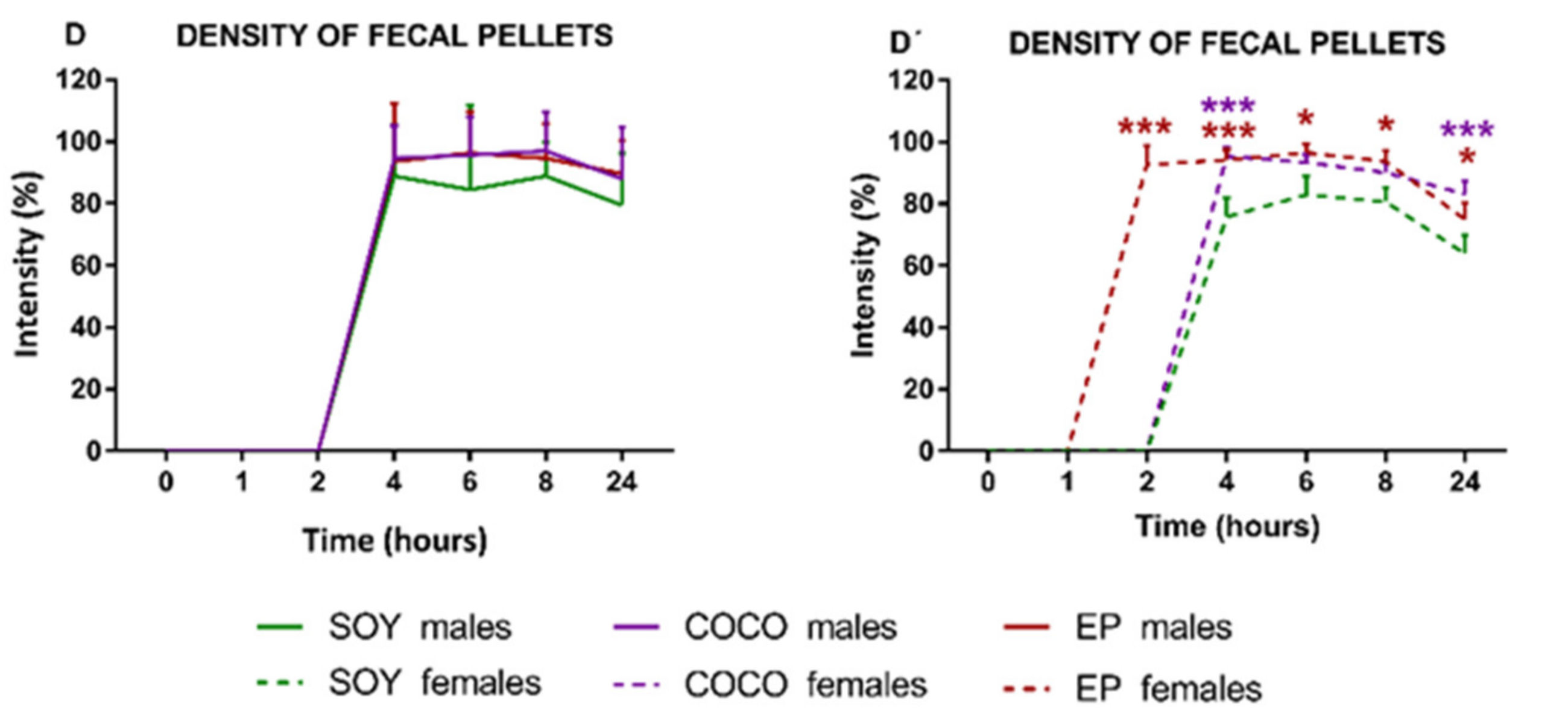
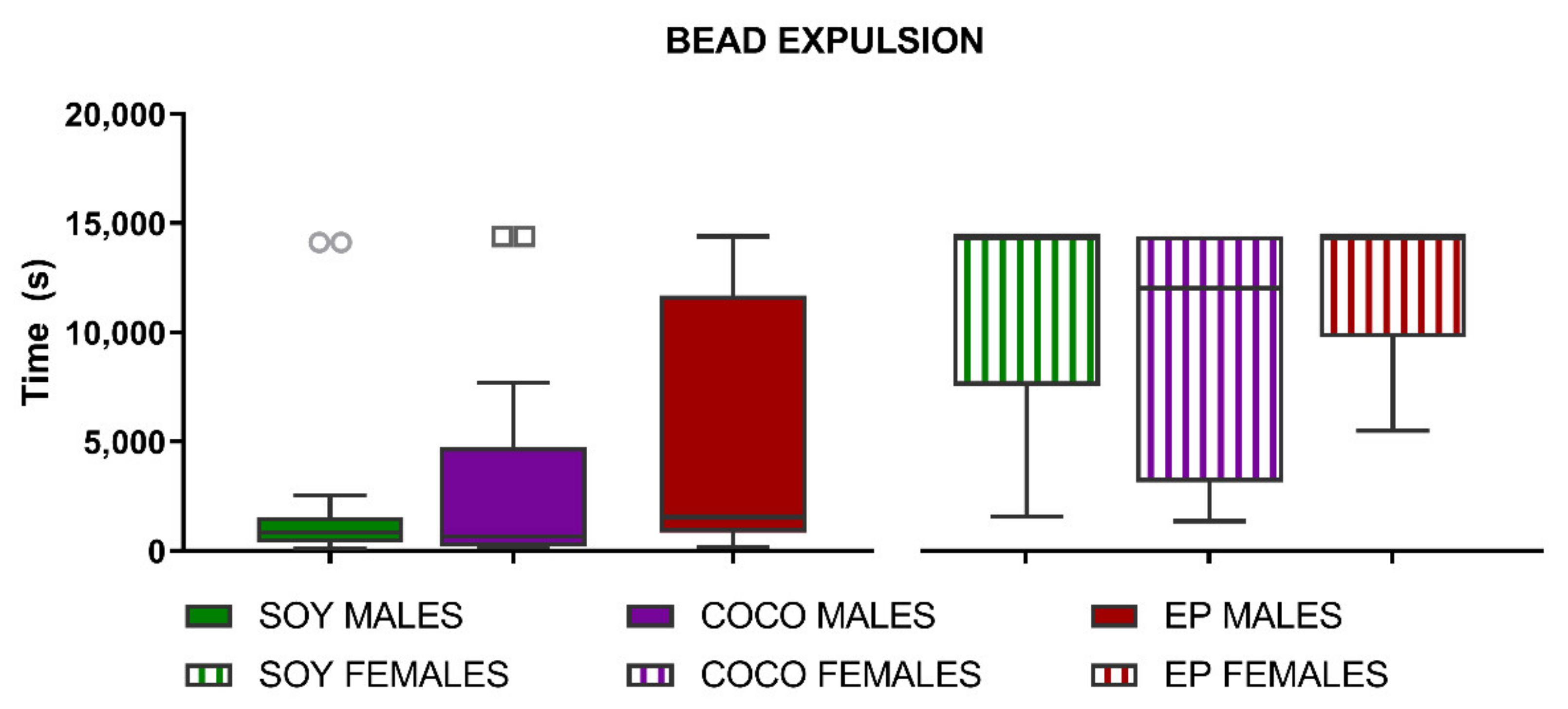
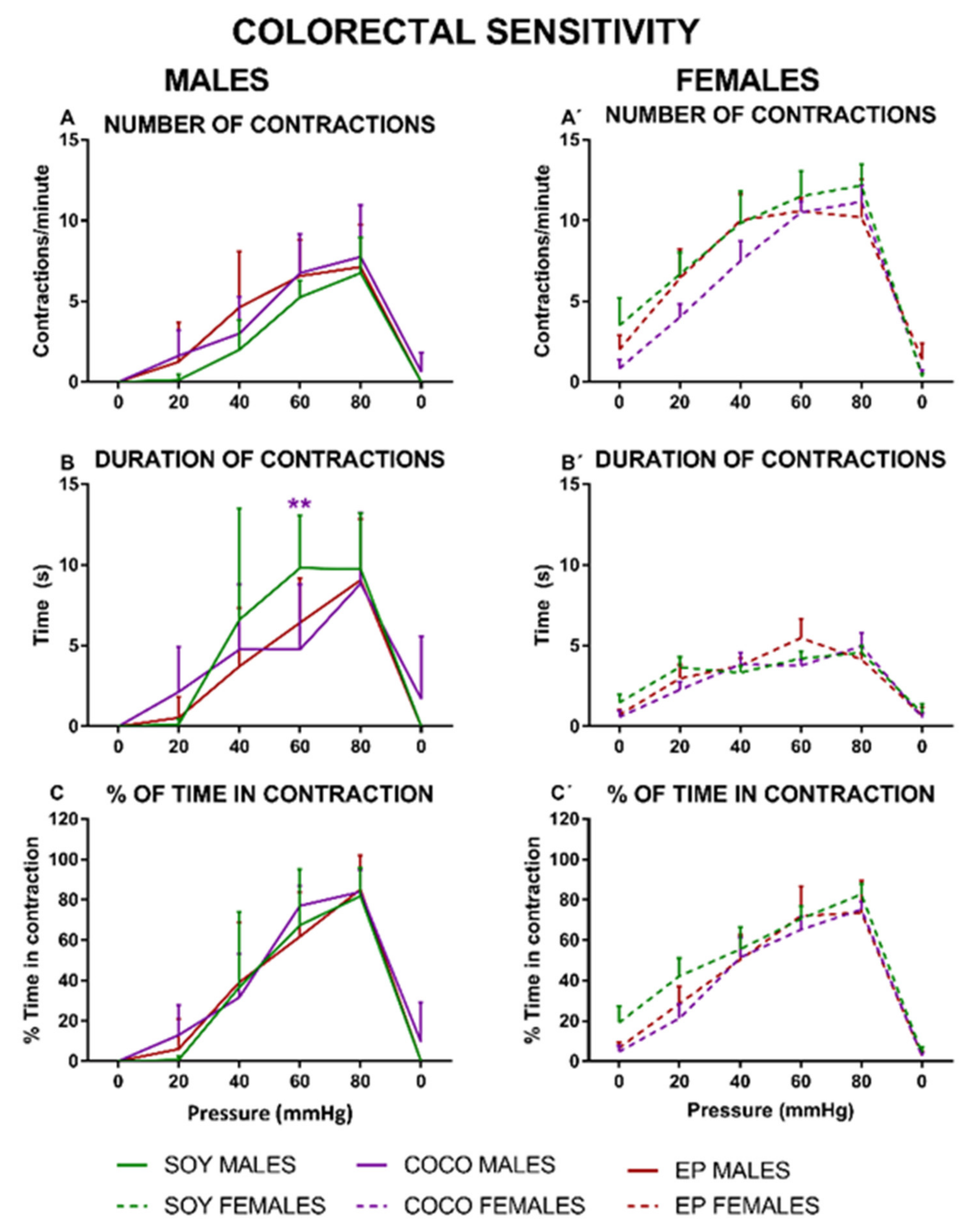
| A | |||
| Ingredients (%) | SOY | COCO | EP |
| Corn starch | 39.75 | 39.75 | 39.75 |
| Casein (>85% of protein) | 20.0 | 20.0 | 20.0 |
| Maltodextrin | 13.2 | 13.2 | 13.2 |
| Sucrose | 10.0 | 10.0 | 10.0 |
| Soybean oil | 7.0 | 3.5 | 3.5 |
| Coconut oil | - | 3.5 | - |
| Evening primrose oil | - | - | 3.5 |
| Fiber (cellulose) | 5.0 | 5.0 | 5.0 |
| Mineral mix | 3.5 | 3.5 | 3.5 |
| Vitamin mix | 1.0 | 1.0 | 1.0 |
| L-cysteine | 0.3 | 0.3 | 0.3 |
| Choline Hydrogen Tartrate | 0.25 | 0.25 | 0.25 |
| Tertiary-Butylhydroquinone | 0.001 | 0.001 | 0.001 |
| Total | 100 | 100 | 100 |
| Energy density (kcal/kg) | 4030 | 4030 | 4030 |
| Energy from proteins (%) | 20 | 20 | 20 |
| Energy from lipids (%) | 16 | 16 | 16 |
| Energy from carbohydrates (%) | 64 | 64 | 64 |
| B | |||
| Type of Fatty Acid | SOY (%) | COCO (%) * | EP (%) * |
| SATURATED FAs | 14 | 52.2 | 11.1 |
| C8:0 caprylic acid | 3.55 | ||
| C10:0 capric acid | 2.85 | ||
| C12:0 lauric acid | 23.4 | ||
| C14:0 myristic acid | 9.1 | ||
| C16:0 palmitic acid | 10 | 9.9 | 8.16 |
| C18:0 stearic acid | 4 | 3.4 | 2.94 |
| MONOUNSATURATEDLCFAs | 23 | 14.9 | 14.97 |
| C18:1 n-9 oleic acid | 23 | 14.9 | 14.97 |
| POLYUNSATURATEDLCFAs | 58 | 30 | 70.56 |
| C18:2 n-6 linoleic acid | 51 | 26.4 | 62.44 |
| C18:3 n-3 linolenic acid | 7 | 3.55 | 3.5 |
| C18:3 n-6 Gamma-linolenic acid | 0.05 | 4.62 | |
| Others # | 5 | 2.9 | 3.38 |
| Total | 100 | 100 | 100 |
| Sex | SOY | COCO | EP | |
|---|---|---|---|---|
| Ileal damage (a. u.) | Males | 1.83 ± 0.98 | 2.83 ± 1.7 | 3.00 ± 0.89 |
| Females | 2.00 ± 1.1 | 1.83 ± 0.75 | 2.33 ± 1.21 | |
| Colonic damage (a. u.) | Males | 3.83 ± 1.94 | 3.66 ± 0.82 | 4.16 ± 1.33 |
| Females | 3.16 ± 0.98 | 3.33 ± 1.03 | 3.66 ± 1.21 | |
| Colonic longitudinal muscle thickness (µm) | Males | 47.40 ± 19.15 | 40.60 ± 3.82 | 44.50 ± 9.27 |
| Females | 41.10 ± 8.99 | 43.80 ± 13.75 | 42.70 ± 14.7 | |
| Colonic circular muscle thickness (µm) | Males | 185 ± 46.59 | 184 ± 27.4 | 209 ± 44.49 |
| Females | 183 ± 32.9 | 192 ± 60.13 | 209 ± 91 | |
| Number of mast cells (n) | Males | 7.01 ± 3.86 | 8.10 ± 3.67 | 7.78 ± 2.23 |
| Females | 6.46 ± 4.07 | 7.05 ± 4.11 | 7.80 ± 2.81 |
| Brain | Gut | |||||||||
|---|---|---|---|---|---|---|---|---|---|---|
| Sex | Diet | Exploration & Locomotion | Grooming | Colonic Sensitivity | Transit | Content Density | ||||
| S | SI | C | CR | C | FP | |||||
 | COCO | X | X | X | X | |||||
| EP | <X | X | X | |||||||
 | COCO | <X | X | X | X | X | ||||
| EP | X | X | X | X | X | |||||
Publisher’s Note: MDPI stays neutral with regard to jurisdictional claims in published maps and institutional affiliations. |
© 2021 by the authors. Licensee MDPI, Basel, Switzerland. This article is an open access article distributed under the terms and conditions of the Creative Commons Attribution (CC BY) license (https://creativecommons.org/licenses/by/4.0/).
Share and Cite
Jacenik, D.; Bagüés, A.; López-Gómez, L.; López-Tofiño, Y.; Iriondo-DeHond, A.; Serra, C.; Banovcanová, L.; Gálvez-Robleño, C.; Fichna, J.; del Castillo, M.D.; et al. Changes in Fatty Acid Dietary Profile Affect the Brain–Gut Axis Functions of Healthy Young Adult Rats in a Sex-Dependent Manner. Nutrients 2021, 13, 1864. https://doi.org/10.3390/nu13061864
Jacenik D, Bagüés A, López-Gómez L, López-Tofiño Y, Iriondo-DeHond A, Serra C, Banovcanová L, Gálvez-Robleño C, Fichna J, del Castillo MD, et al. Changes in Fatty Acid Dietary Profile Affect the Brain–Gut Axis Functions of Healthy Young Adult Rats in a Sex-Dependent Manner. Nutrients. 2021; 13(6):1864. https://doi.org/10.3390/nu13061864
Chicago/Turabian StyleJacenik, Damian, Ana Bagüés, Laura López-Gómez, Yolanda López-Tofiño, Amaia Iriondo-DeHond, Cristina Serra, Laura Banovcanová, Carlos Gálvez-Robleño, Jakub Fichna, Maria Dolores del Castillo, and et al. 2021. "Changes in Fatty Acid Dietary Profile Affect the Brain–Gut Axis Functions of Healthy Young Adult Rats in a Sex-Dependent Manner" Nutrients 13, no. 6: 1864. https://doi.org/10.3390/nu13061864










